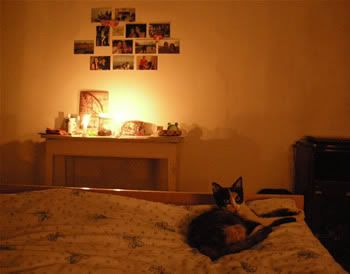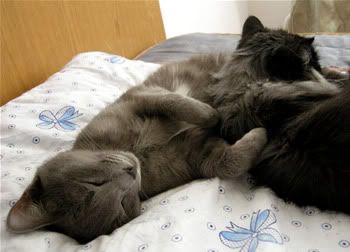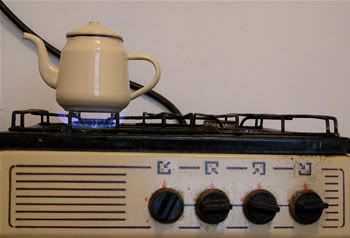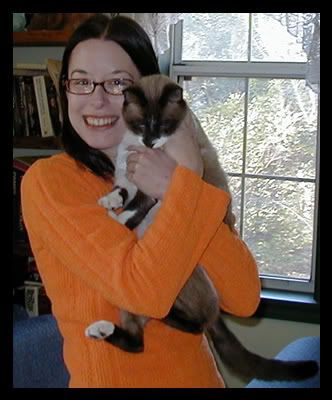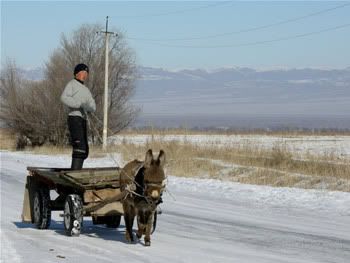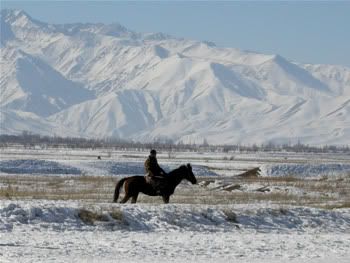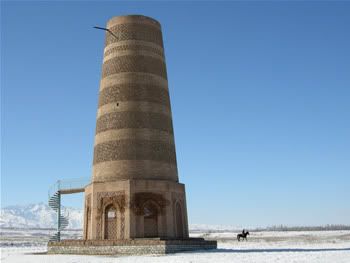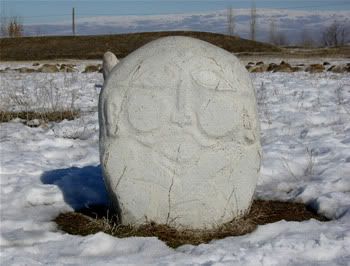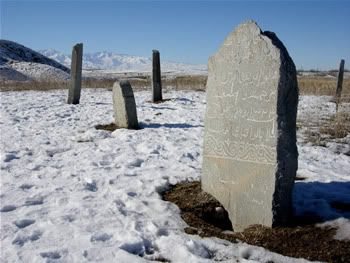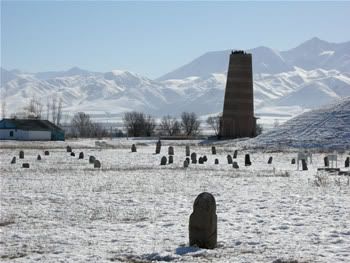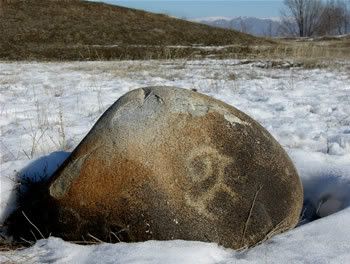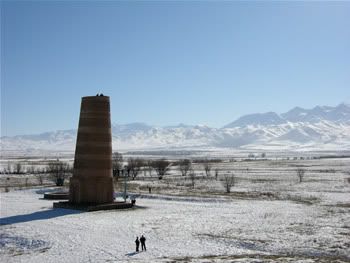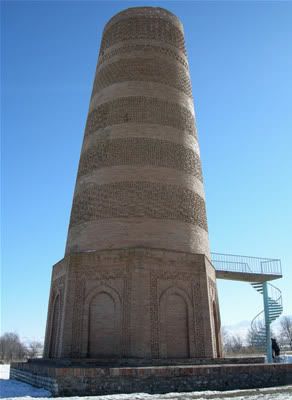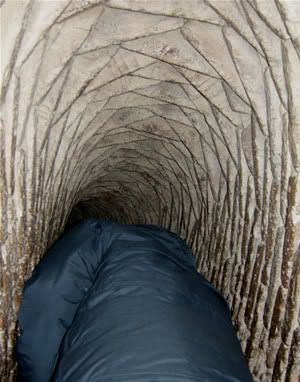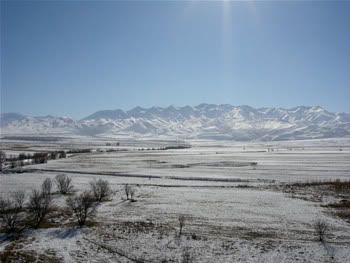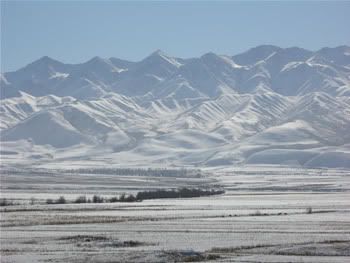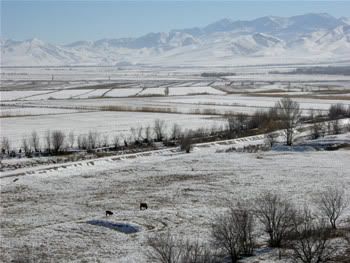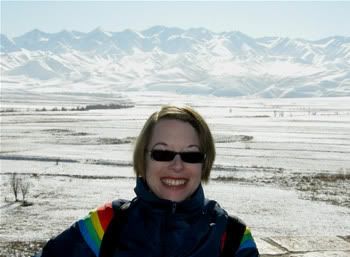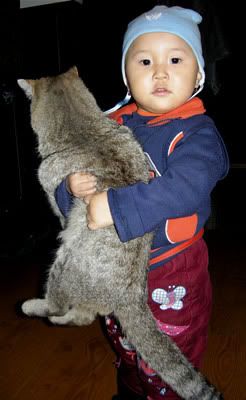Last weekend my boss, Kendje, and her husband, Bayan took me, as well as Katy and Austin (other teachers) and Kelly (their host daughter) to Lake Issyk Kul. It was an incredible trip, and I took around 200 photos, nearly 80 of which I felt were good enough to upload. I’ve only posted photos a handful of photos below, so PLEASE CLICK HERE to view the entire set. Trust me, it’s worth it.
If you look at any map of Kyrgyzstan, you will see a large lake in the north-eastern quadrant of the country. This is Lake Issyk Kul. At around 10:00 on Saturday morning, Kendje, Bayan, their daughter Aishyola, Kelly, Austin, Katy and I loaded into the van and began the roughly four-hour long journey. We headed eastward along the same road we’d previously taken on our trip to Burana Tower, although obviously we continued on much farther this time. After about two hours, we stopped at the bank of the Chuy River at the base of the mountains for lunch. The weather was chilly, but the sky was a brilliant blue, and the land surrounding the river was spotless save for brilliant white snow. We dined on chicken, cheese and eggs while drinking hot tea and nursing shots of vodka, then we continued onward.
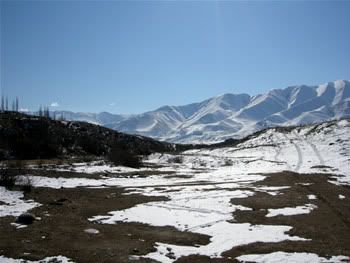
This is where we stopped for lunch. You can see our tire tracks to the right, where we drove down from the main road.
After lunch, our van began to wind its way up into the mountains. Soon we stopped at a monument on a brown hillside, overlooking the steep valley from which the Chuy River descended. The monument was to Kyrgyz people massacred by the Russians in 1916, as depicted on a moving relief.
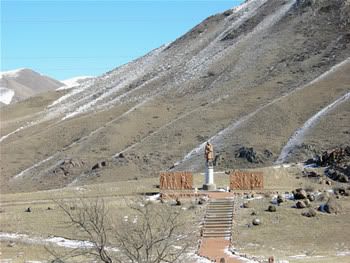
This is the monument to the massacres of 1916 as seen from the highway.
After exploring the area surrounding the monument, we got back into the van and ascended even higher into the mountains. Near the top of the mountain pass we stopped again. At the side of the road was a natural mountain spring, considered sacred by the local people. Numerous prayer rags had been tied to surrounding trees, and nearly every car stopped, the passengers disembarking to drink, wash, and pray. The spring was guarded by a sad dog – one who had obviously given birth recently, although sadly it didn’t look as though she had been suckled in a while – who sat patiently, awaiting hand outs.

A passerby washes and prays in the sacred spring
After leaving the spring, we began our descent out of the mountains, toward the lakeside village of Balykchy, the western-most village on the shores of Lake Issyk Kul. Issyk Kul translates to “hot lake” although the waters were certainly not hot; at Balykchy, the lake was actually frozen. Apparently, this is the first time in recorded history that so much of the lake has frozen, on account of this also being the coldest winter in recorded history. How is it that a native southerner like myself managed to land in Russia during their coldest winter in decades, and then repeated the process here in Central Asia? Sigh. Anyway, this part of the trip reminded me a lot of my trip to Siberia’s Lake Baikal, as we all walked out onto to ice.
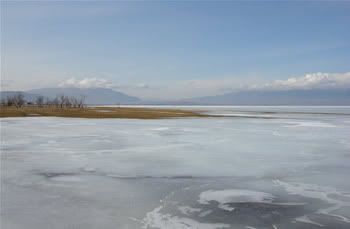
Our first view of the frozen part of Issyk Kul at Balykchy
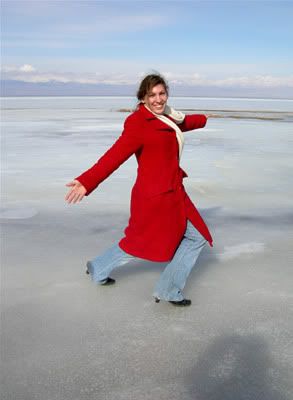
Katy dances on the ice at Balykchy
When we left Balykchy, we all needed to use the bathroom. Unfortunately, while the lake is a popular tourist destination in summer, there were no facilities available for us to use at this time of year. Now, I’m not opposed to going au naturale, but the area was quite devoid of trees big enough to squat behind. So, we got back in the van and continued off along the southern shore of the lake in search of a nice place for a pit stop. The further eastward we drove, the narrower the road became. Additionally, obstacles such as cows, sheep and horses became much more common!

Highway obstacles: sheep, cows and horses
Soon we arrived at a spot with decent enough ground cover for a pit-stop, which also happened to have excellent scenery:

I loved this view of the cows with the tree and the lake in the background.
After relieving ourselves, we once more packed into the van and drove even further eastward. We arrived at a fairly new monument commemorating (I think...) Manas, the national hero of Kyrgyzstan.
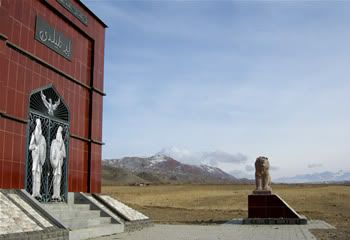
Possible monument to Manas
Next to the monument to Manas was a traditional Kyrgyz Islamic cemetery. Now, I *love* cemeteries in general, and the cemeteries here are particularly fascinating to me simply because they are so very different from cemeteries back home. Just take a look:

Many of the graves were covered with yurt-shaped monuments.
After exploring the cemetery, we backtracked about a kilometer or so to our final destination: the small village of Karakoo. (It’s pronounced Kara-koh, and is not to be confused with the city Karakol on the eastern edge of Issyk Kul.) Karakoo is the city where Bayan was born, and we stayed in the house of his 85 year old mother, his younger brother and his family.
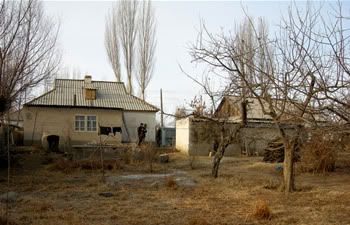
This shot was taken from the rear of the property near the outhouse (a pit squatter, of course). The house is on the left, with barns and sheds on the right.
The time we spent at their home was simply fantastic. We ate nearly continuously, from a sumptuous table laden with delicious Kyrgyz dishes.

Yum!
After our main course, Aishyola (Kendje’s daughter) and her Karakoo cousins performed what I can only describe as a variety show for us: singing, dancing and theater, complete with costumes. I have one photo below, but the photos really don’t do this event justice. I'm in the process of uploading vidoes to YouTube, but with the speed of connections here, who knows when they'll be ready.

After the children were finished performing, it was time for everyone to sing. Singing is something that is definitely missing from American culture outside of religious gatherings, and that’s really too bad. The tradition (of this family at least) was to make a bowl of nasty water (containing hot red pepper, salt, oil, and table scraps) which would be passed from one person to another. When you’re handed the bowl, you’re given a choice: you must either sing, or you must drink the whole thing. Obviously, we all sang, although unfortunately none of us on the American half of the gathering was particularly skilled in this area. In addition, we had a hell of a hard time coming up with songs that were singable which we all knew. Meanwhile, not only could all of our Kyrgyz hosts sing well, but everyone of them joined in with nearly every Kyrgyz song. I shot a short video of our Kyrgyz hosts singing, and I'll have it online for you as soon as possible.
After singing and chatting until around 10:00, we retired to our respective bedrooms for the night. In the morning, I explored the small farm where Bayan’s family lived. They raised sheep and chickens, so there were plenty around to photograph. They also own a dog named Rex who is super awesome and utterly adorable. Seriously, check out my flickr set!
After breakfast, we piled back into the van again and drove southward from Karakoo. We arrived at a place with some special stones. Allegedly, the largest of these stones was once carried by the Kygyz hero Manas. Currently, it is tradition for local young men to attempt to lift as many of these stones as possible, beginning with the lightest and stopping with whichever one is too heavy for them to hoist. Austin successfully lifted three, and then we convinced him not to try any further, so as not to throw out his back or anything.
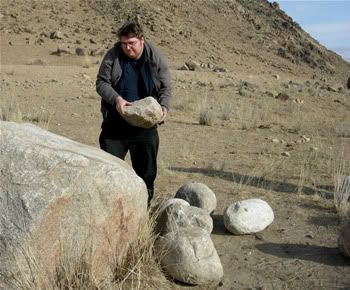
Austin proves his manhood. Meanwhile, the gigantic stone on the left is the one allegedly hefted by Manas.
Next to these special stones are the graves of forty martyrs, killed by the Russians in 1916. Apparently these forty men sent the rest of their village eastward through the valley, while they stayed behind to fight. They were surrounded and slaughtered, but the Russians didn’t pursue the remainder of the villagers. The view of the valley from the martyrs’ graves is spectacular.
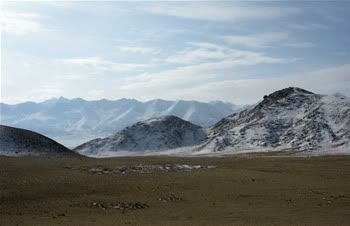
The view from atop the hill where the graves of the forty martyrs lie.
Not far from the graves of the forty martyrs sit the ghost town-like remains of a kolkhoz, or collective farm, which was destroyed following the collapse of the Soviet Union. Today what remains of the farm is over run by cows and sheep, herded by local shepherds.
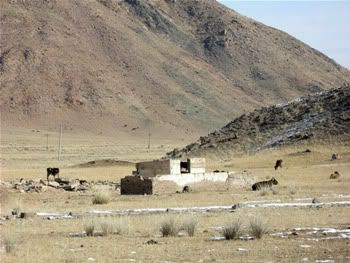
Ghost town kolkhoz
The kolkhoz sits at the base of some small mountains (or large hills, depending), and from the top of these small hills one can see a splendid view of yet another valley. One of the small villages in this valley is where Kendje was born. She wanted to take us there, but unfortunately, the roads were too icy.

View from atop the "small mountain" behind the kolkhoz. China lies behind those mountains.
At the site of the former kolkhoz, we met a local man who rode up on a horse. He spoke with us for a while. It turned out that he knew both of Bayan’s parents, and had been a student of Bayan’s mother!

Kelly, shepherd, Austin, me and Katy
After leaving the site of the kolkhoz, we drove back to the shore of Lake Issyk Kul. There I was able to ride a horse – just around a field, so not very far. This was the calmest (or perhaps laziest) horse I have ever ridden, and it took quite an effort to get him to even trot, although I did manage to pull that off. I think it would take an act of god to make the thing canter!
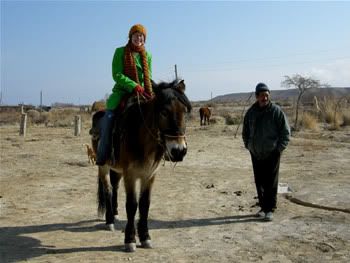
Me, riding the world's laziest horse
We walked along the shore of the beach, which was utterly breathtaking: sparkly blue water below a bright blue sky dotted with puffy white clouds. In the distance we could barely make out the mountains ringing the northern shore of the lake. Austin was the only one brave enough to venture into the lake itself. I stuck my fingers in and figured there was no way I was going to join him!
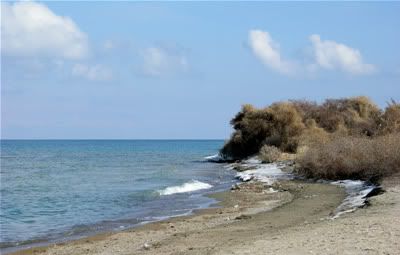
Oh, gorgeous Issyk-Kul!
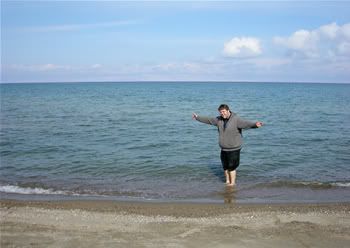
Austin braves the frigid waters of the lake
After exploring the shore of Issyk Kul, we drove back to Karakoo for one last meal, then packed ourselves back into the van for the journey back to Bishkek. The weekend was simply wonderful: relaxing with great people while eating delicious food and enjoying beautiful scenery and breathing clean air... life doesn’t get much better.
(And one last reminder... if you haven’t done so already, please check out the complete set of photos from this trip. Trust me, you won’t be sorry!)


